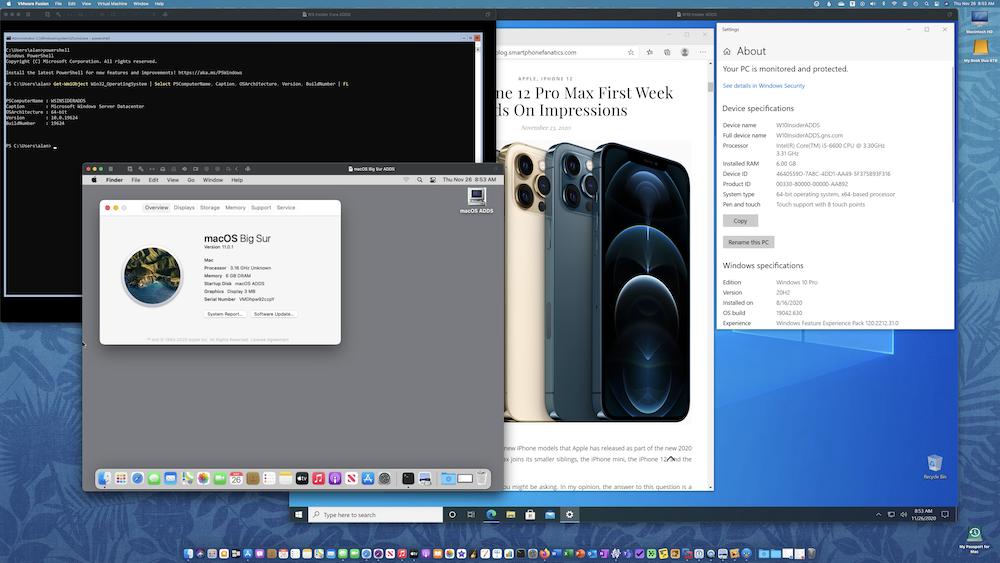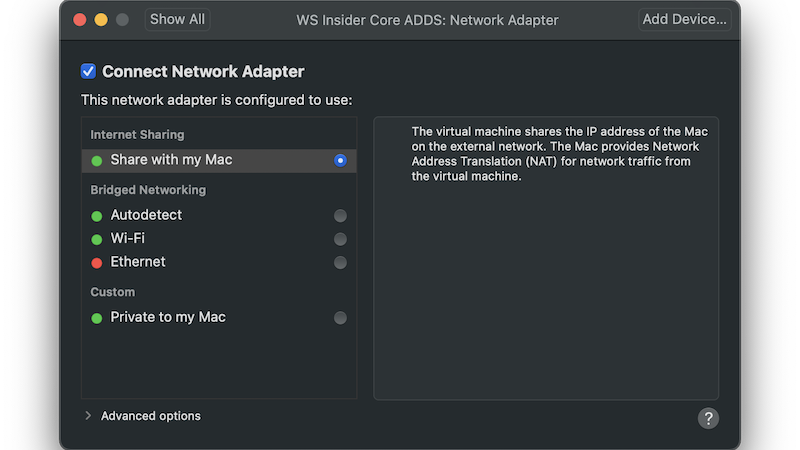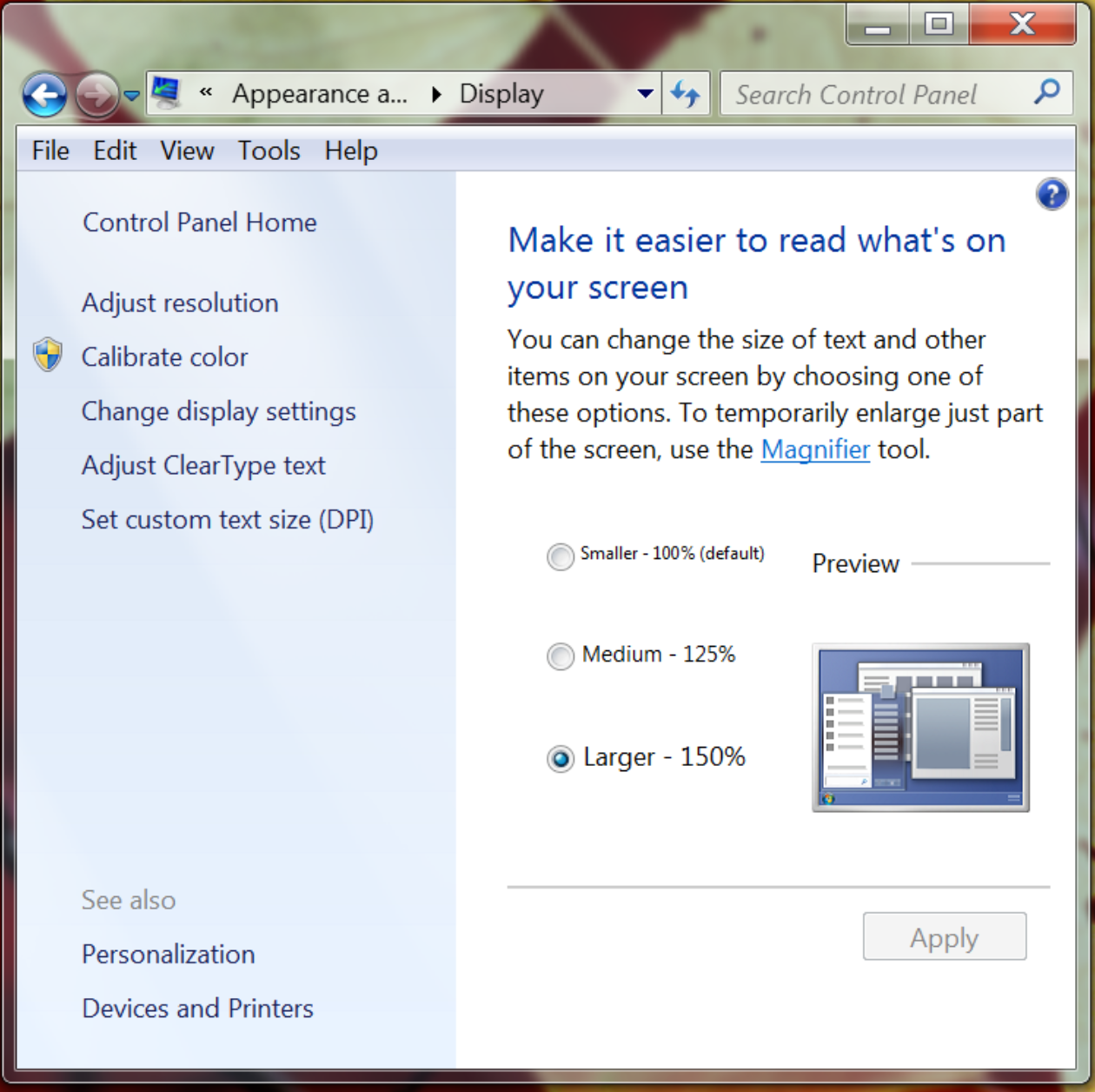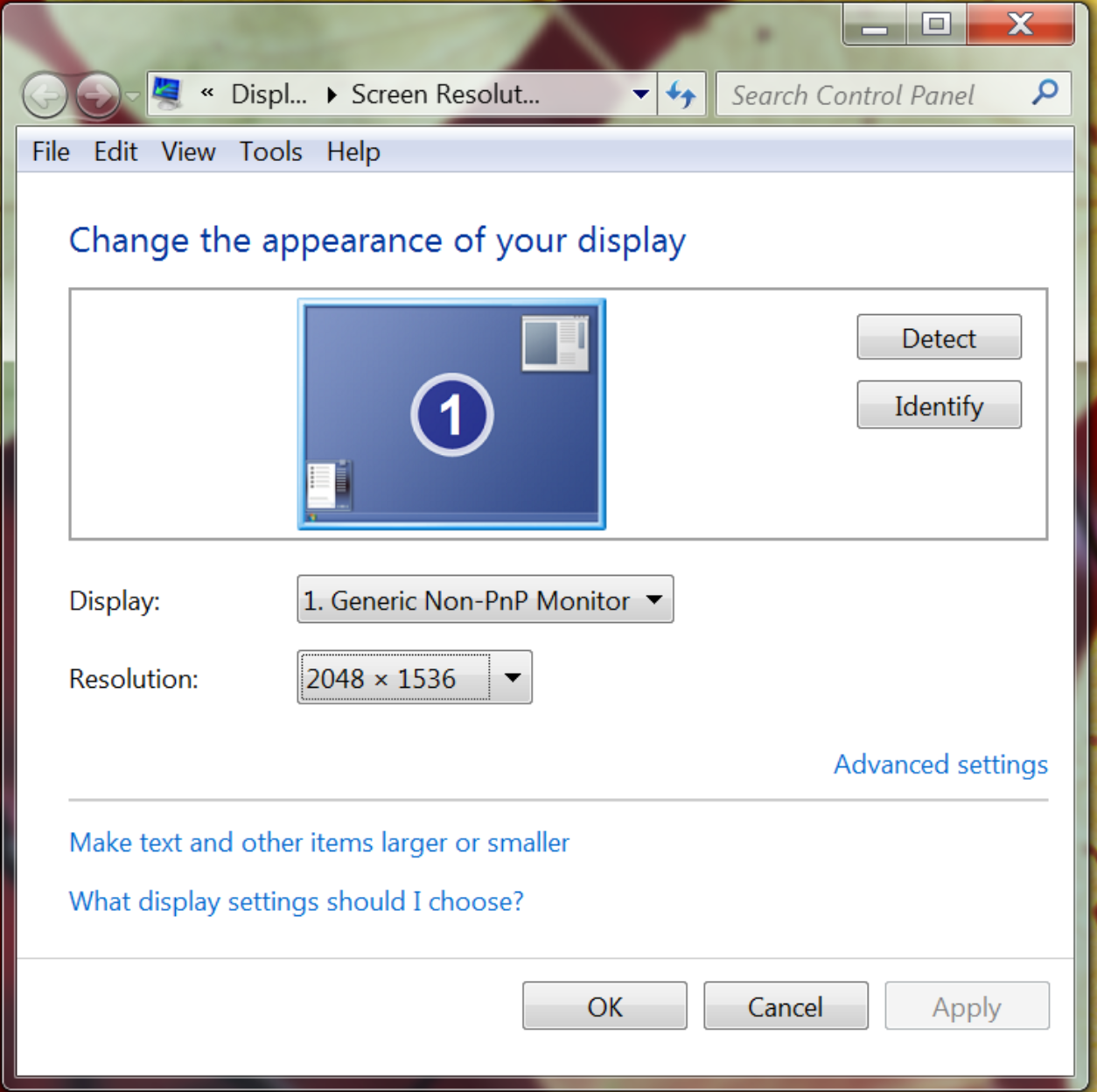DOS machines aren’t Macs and this video proves it! Come watch me bang my head against the wall while I try to get a 5.25-inch 360kb floppy drive to work inside a 2005 Dell Optiplex GX520 mini-tower PC.
-
-
Building a Virtual Active Directory Test Lab

Windows Server Core, Windows 10 Pro, and macOS Big Sur in an AD domain. It has been a long time since I build a Microsoft Active Directory lab environment. Years ago, I put together a test lab with physical white box machines that I built. The popularity of virtual machine technology makes all of that space hogging, wires everywhere, make your wife annoyed mess a thing of the past.
This will be the first in a series of posts about how I setup a virtual test lab using VMware Fusion on my Mac.
Microsoft Insider Programs
I have been dabbling with virtual Ubuntu machines over the last year or so, and I wanted to do something a little different. Microsoft offers IT pros a few of their products free of charge, for non-production use, of course, for training and development purposes as part of the Insider program. IT types who want to play along will be interested in the Windows 10, Windows Server (Core), Visual Studio Preview, and SQL Server Developer. There are also programs for Microsoft Edge and Office 365, if you are so inclined.
Make Up of the Lab
I’m looking for a playground so my requirements are pretty low. To build my virtual lab environment I will be using my everyday use 2015 5K iMac with a 3.3Ghz Quad-Core Intel Core i5 CPU and 32GB of RAM. Faster CPUs and more RAM is always better, however, in 2015 my needs were different. I am also running VMware Fusion Pro 12 as the hypervisor on my iMac. Due to the physical constrains of my iMac, not all of these virtual machines will be running all the time. Likewise, they will not be optimized for speed.
As a side note, anyone purchasing a new M1 Apple Silicon powered Macintosh – the 2020 MacBook Air, the 2020 2-port USB-C 13-inch MacBook Pro, or the 2020 silver Mac mini – will not currently be able to run virtualization technology like VMware Fusion or Parallels Desktop because these apps haven’t yet been updated to work on M1 and Apple’s new virtualization technology layer.
For my initial lab setup, I plan on deploying the Insider editions of Windows Server Core, Windows 10 Pro, and then building an Active Directory domain to manage the environment. Then, I added a virtualized macOS 11 Big Sur VM. In the future, I plan to deploy an IIS web server on my domain controller and the developer edition of SQL Server on another AD member Core server. I will be using Microsoft’s RD Client for macOS to connect to the Windows machines. To network the virtual machines together, I will use the “Share with my Mac” VMware Fusion networking option. From my home network perspective, there will only be one DHCP1 IP network address being used (by my iMac) and each VM will get it’s own private IP address thanks to the magic of NAT2.

VMware Fusion 12’s Network NAT Option For my next article in this series, I will discuss the setup process for Windows Server Core.
-
Thoughts on Subscription Services and the Rumored Apple One Bundle
I have been thinking about subscription services a lot lately. Newspapers, cable TV and streaming services, and most recently, podcast subscriptions. The only Apple subscriptions that I currently have are iTunes Match (yes, it’s still a thing) and the iCloud 200GB storage plan so I can share my iCloud storage space with my family using the Family Sharing feature.
One-Time Transactions vs. Recurring Revenue
Back in a time before the App Store, consumer software was a one-time transaction. Think back to how you purchased productivity software at the consumer or “prosumer” level a decade ago. You purchased a new PC and the software came pre-installed and you used it. Prosumers might have purchased big packages like Microsoft Office or Adobe Photoshop. You paid hundreds of dollars up front and ran the software until you needed a feature that was in a newer version or would no longer run on your PC’s operating system after an upgrade, at which point, you would purchase the software again. To reward customer loyalty, software developers would often offer customers a discount on the purchase of the current version.
For businesses customers, the software model worked differently. Business customers would purchase a software license and with it, annual support agreements. Annual support agreements gave IT departments access to frequent software updates and technical support. The annual software maintenance agreements would typically run between 20-30% of the original purchase price.
Fast forward to today. Subscription services are a lot like the maintenance agreements, where each subscription provides the software developer with a sustained revenue stream in exchange for regularly updated software packages.
App Store and the Race to the Bottom
With the introduction of the App Store on July 10, 2008, the consumer software model was forever changed. The iOS App Store was the point in time the popularized the idea of paying for software once and then getting free updates for life. The problem with that model is that it is not sustainable long term. Eventually, you will reach a peak customer base. When no new purchases coming in, there is no revenue to sustain development efforts. The lack of an upgrade system in the App Store further complicated matters. In the App Store, there was no way that developers could release, in effect, a 2.0 upgrade of their product and charge existing users a fee to recoup the development costs for the new features. To try and get customers to buy software, developers kept lowering and lowering prices to the point where many people would scoff at the idea of paying, $9.99, $4.99, $1.99 or even 99-cents for a game or app. This model, several years on, has proven to not be sustainable.
Subscription Services
Then, in 2016, Apple introduced the idea of app subscriptions. Rather than purchase an app, you subscribed to the app or a family of related apps from a single developer. You got the software for a monthly fee. Some developers offer a slight discount when a subscription is purchased annually. In exchange for the recurring subscription fee, developers would have the capital to fund the further development and support of their software.
The notion of software subscriptions are not new. Looking to corporate IT solutions, annual software maintenance programs have essentially been rebranded as subscription services. Software subscriptions are also known as software-as-a-service, or SAAS – because IT loves acronyms. I first noticed SAAS software with the introduction of the Microsoft Office 365 service, now known as Microsoft 365. About the same time, Adobe started talking up their subscription product suite, Create Cloud. The Microsoft 365 and Creative Cloud SAAS subscriptions offer customers a lower annual software cost in exchange for software suites with guaranteed feature enhancements and bug fixes. I happily moved from a retail one-time purchase of Microsoft Office 2007 to Office 365 and Office 2013. Rather than spending $400 every few years, I would spend $99 annually. In exchange for my Microsoft subscription, I could share Office with my family and get additional OneDrive storage space. A lower price with more features. That sounds like a fair trade to me.
Where’s the Apple Bundle? On the Way, Likely.
Which brings us back to Apple and their subscription services. Apple, back in 2018, publicly started to talk about “services” as being the next revenue generating product. The iPhone has been the largest revenue generator for the company for many years, however, iPhone sales have stabilized. The company needed a plan for sustained revenue. The answer that Apple has turned to is a synergy between hardware and online products. Customers would by the hardware and then buy monthly subscription services. The hardware plus services model gives Apple a sustained revenue stream like the ones that Microsoft and Adobe have for Office 365 and Creative Cloud.
Apple has released a scatter shot of services: iTunes Match, iCloud storage upgrades, iCloud Photo, Apple Music, Apple News+, Apple TV+, and Apple Arcade. If you subscribe to a small number of Apple services, say Apple Music and Apple Arcade, the cost is $15/mo or $180/yr. Subscriptions to Apple Music (Family), Apple TV+, Apple Arcade, and a bump to iCloud storage can easily coast $336/yr. What is missing is the bundling of services at a lower price. Adobe’s Creative Cloud works that way. So does Amazon Prime. Why hasn’t Apple gotten into the bundle game?
There have been a number of possible explanations for this this. The first being one that I mentioned earlier, that Apple is just bad at services. Another is that Apple is having trouble with the licensing terms of bundling Apple Music with other services, as suggested by Chance Miller writing for 9to5Mac. In the early days of online music sales, record companies saw Apple become a powerful middleman between they and the music download buying customers, dictating terms of how music could be purchased through the iTunes Music Store. It was a cautionary lesson for the music industry, for sure, and I feel a contributing factor in the rise of direct to customer streaming services like Disney+. Why share revenue with Apple when studios can have a direct relationship with their customers. Along those same lines, it is possible that Apple News+ could be suffering from a similar content licensing and customer relationship headaches.
Despite the challenges of navigating the legal implications of bundling Apple’s own in-house services (i.e.: Apple Arcade, iCloud Storage, Apple TV+) with services that are built on top of content licensing deals (i.e.: Apple Music, Apple News+), there seems to be a light at the end of the tunnel. Leaker Mark Gurman, writing for Bloomberg, suggest that Apple could finally be readying a services bundle as early as this fall alongside the launch of new iPhone hardware.
Apple Inc. is readying a series of bundles that will let customers subscribe to several of the company’s digital services at a lower monthly price, according to people with knowledge of the effort.
As someone who has been eyeing Apple Arcade as a way to get away from freemium games which require In App Purchases (IAPs) to advance, the idea of being able to get a bundle with more iCloud storage and a games subscription is appealing. I suspect that Apple will focus on the high visibility services of Apple Music, Apple TV+, and Apple News+ to drive adoption and that the smaller servers, like extra iCloud storage and Apple Arcade will be relegated to “sign up and get them for free” status in the bundle.
Could we get an Apple One service this fall that includes Apple Music Family, Apple TV+, Apple News+, Apple Arcade, and 200GB of “free” iCloud storage? How much would this service offering cost? Assuming that someone subscribes to those services, one would spend about $38/mo. What would a price that a customer would shrug and automatically subscribe to a service for? My guess is that for a made-up bundle like the one I mentioned, a customer might expect a 20% discount, bringing the cost down to $25/mo. That seems reasonable. You end up paying for the “big” services and get the “smaller” services included in the monthly price.
Conclusion
The idea of an Apple bundle, like the recently rumored Apple One, is one that customers have been asking about since Apple first started playing with services. I think that Apple customers will go for a single monthly plan that will enhance the experience and joy of using their Apple devices, particularly the iPhone in the vein of an Amazon Prime service.
For me, a $3/mo 200GB iCloud plan is sufficient to prevent my family from seeing the dreaded “Your iCloud storage is almost full” pop-up on a regular basis. Being able to play games on all of my Apple devices for $5/mo without questionable game mechanics is nice. While I do not use a streaming music service, my wife and kids do. Being able to add an Apple Music Family subscription would be a nice perk for them to listen to their music ad-free. For me, would an additional $15-20/mo make sense? To give my family an ad-free music listening experience and some extra TV content, I can see myself signing up Apple One this fall.
-
Configuring a Windows VM to Run Properly on a 5K iMac at Full Resolution
Earlier this week, I was working from home while and taking some vacation time while my car was getting serviced. (But that is an entirely different post for a different time.)
While working, I wanted to use a copy of a corporate Windows 7 VMware guest machine on my 5K iMac. The only problem is that the Windows 7 text is microscopically small on the iMac, which is running at its maximum screen resolution of 3200 x 1800. On my home iMac, I am running VMware Fusion 8.5.8.
The problem of super-small text is a known issue and VMware has published a KB article on the topic titled “Retina display support in VMware Fusion (2034670)“.
However, the steps for adjusting Retina display support in the KB article didn’t exactly work for my configuration of Windows 7 guest. In addition to the virtual machine settings provided by VMware, I wanted to share the configuration adjustments that worked for me, and hopefully, by extension, may also help you.
To get started, I copied the guest virtual machine to my virtual machine folder on my iMac’s hard drive. Then, I started up the virtual machine, logged in with an administrator level account, and uninstalled the VMware Tools package that was installed by VMware Workstation, and then reinstalled the version of VMware Tools from Fusion. This step might be unnecessary, but I wanted to keep the version of VMware Tools consistant with the version that I have on my iMac for Fusion 8.
After the shell game with VMware Tools has finished, I shutdown the Windows 7 guest. Next, I used the directions that VMware provided in their KB article.
Finally, to make the text in the Windows 7 guest virtual machine readable, I had to do two more things:
1. In Control Panel > Appearance and Personalization > Display, I set the text size to “Larger – 150%”.

2. In Control Panel > Appearance and Personalization > Display > Screen Resolution, I set the Windows 7 resolution to 2048 x 1536.

For the Windows screen resolution step above, you may want to go one resolution step up or down from there, depending on your preferences.
Since we are talking about a Windows machine, I rebooted the Windows 7 guest just to test everything out. Now I am able to comfortably run and read the text on my Windows 7 guest virtual machine on my 5K iMac running at full resolution.
-
Microsoft’s ANS Alerts Are No Longer Free
Tomorrow’s Microsoft “Patch Tuesday” is going to seem a little bit more confusing than past patch days for the majority of Microsoft’s customers.
“They’ve gone from free to fee, and for really no particular reason,” said Andrew Storms, vice president of security services at New Context, a San Francisco-based security consultancy, in an interview.”
Microsoft Windows administrators have been familiar with the ANS, or Advanced Notification Service emails that were sent out a head of Microsoft’s scheduled patch release date with information regarding what software was to be patched, their classification of the patch, and associated knowledge base articles. Starting with tomorrow’s patch Tuesday, Microsoft will not provide advanced notice of patches.
“Customer feedback indicates that many of our large customers no longer use ANS in the same way they did in the past due to optimized testing and deployment methodologies,” said Chris Betz, senior director at the Microsoft Security Response Center (MSRC). “While some customers still rely on ANS, the vast majority wait for Update Tuesday, or take no action, allowing updates to occur automatically.”
“Microsoft prefers to call its monthly security release “Update Tuesday,” apparently believing “Patch Tuesday” carries negative connotations.”
So, unless your organization pays for premiere support or is otherwise involved in sharing security information with Microsoft, you will no longer be receiving these email updates.
Personally, I’ve never participated in the online briefings, but I would skim the list of patches, sorry, “updates” that Microsoft would be pushing out to Microsoft Windows Update Servers (WUS) running on private networks. While I’m sad to see the email notices and blog postings go away, for small to mid-sized organizations, I’m not sure that there will be a meaningful impact on day-to-day operations. What will likely become of this is that Windows client and Windows Server administrators will need to pay more attention when testing the latest updates before deploying them on production servers.
[Via ComputerWorld.com…]
-
Rumor: Microsoft is Building a New Browser
A new report on ZDNet by longtime Microsoft watcher Mary Jo Foley, if true, suggests that Microsoft is cooking up a new web browser that is not Internet Explorer 12.
“It turns out that what’s actually happening is Microsoft is building a new browser, codenamed Spartan, which is not IE 12 — at least according to a couple of sources of mine.”
Even if we ignore the “Spartan” Halo reference (Microsoft has chosen to name the Windows 8.1 digital assistant “Cortana” after the fictional computer AI character of the same name that helps Master Chief in their Halo video game franchise), this sounds like a pretty interesting move by Microsoft as Foley goes on to report that the new browser “will look and feel more like Chrome and Firefox and will support extensions.”
So far, I’ve been a support of where CEO Satya Nadella has been talking Microsoft’s products and services. I’ve also been running the Windows 10 Technical Preview (in a virtual machine) for some time now and really like it.
Whatever “Spartan” turns out to be, I’m sure it will be part of the cloud services roadmap that Microsoft has been working steadily toward.
[Via ZDNet.com…]
-
Microsoft’s 1994 Website
Suddenly, I don’t feel so bad about the first website I built using SimpleText and the Netscape browser on my Apple Mac SE/30.
You can see the full version over at Micrososft’s Discover 1994 site.
-
Microsoft Releases Office Apps for Apple’s iPad
In a bold move yesterday, Microsoft, lead by their new CEO Satya Nadella, launched Microsoft Word, Excel, and PowerPoint for the Apple iPad.
I’m not talking about watered down, half-hearted, sort-kinda Office applications, I’m talking about the real, full blown, well featured, iOS native Office applications for the iPad. Did I mention this is Microsoft’s Office on the iOS platform?!
[youtube https://www.youtube.com/watch?v=frpsGFQ4AIY?rel=0]I’m really excited about having Word, Excel, and PowerPoint on my iPad. The apps look and feel great! Taken together with the already released OneNote and OneDrive (formerly known as SkyDrive), Microsoft has seemingly overnight, empowered millions of iPad owning Office users around the world.So what do you get? Available now in the iOS App Store, users can download, free of charge, Word, Excel, and PowerPoint for the iPad. The apps are free and will enable anyone who installs them to read Office documents. If you just happen to be an Office 365 customer, you can sign in to your account from the Office apps on your iPad and instantly have the ability to edit your documents.You will need to have an iPad running iOS 7.0 or later and to edit documents, a Microsoft Office 365 Home subscription.Microsoft’s Office Apps for iPad are available now on the App Store, or you can use these handy download links.
You can read more about Microsoft’s Office Apps for the Apple iPad on the Microsoft blog. -
Microsoft Brings OneNote to OS X
Earlier today, Microsoft released OneNote for Macintosh OS X 10.9 Mavericks.
To use OneNote, you need a free Microsoft account. If you have a OneDrive account, formerly known as SkyDrive, or a subscription to the company’s Office 365 Home Premium, you’re good to go.To install OneNote for Macintosh, you need to be running the aforementioned OS X Mavericks. You also need 235MB of disk space. OneDrive is compatible with OneNote 2010 and later for Windows, and the pre-existing OneNote and OneDrive for iOS devices.
OneNote for OS X with OneNote 2013 in the Background I’m excited about OneNote coming to the Macintosh because I can see myself using it for personal digital notes. (In the corporate environment I work in, there is virtually no one using OneNote for Windows.)I really hope that OneNote for OS X, with it’s features mirroring the Windows functionality, is a sign of things to come. As someone who’s been using Office for Windows and Mac OS X over the last 20 years, it has been really frustrating to have two products that are only the same in name only. Hopefully, we will finally see a Microsoft that lets Office be Office, and not an expensive Windows-only add on.According to Microsoft, OneNote is “free for a limited time,” however, there is no mention of when this offer will expire. OneNote is available now from the Mac App Store. -
SkyDrive To Become OneDrive
Microsoft is planning on renaming their SkyDrive online storage service to “OneDrive.”
It’s almost like the Xbox One fever has infected the SkyDrive team, but that’s not exactly the case.
Ryan Gavin, Microsoft’s General Manager, Consumer Apps & Services puts it this way:
“Why OneDrive? We know that increasingly you will have many devices in your life, but you really want only one place for your most important stuff. One place for all of your photos and videos. One place for all of your documents. One place that is seamlessly connected across all the devices you use. You want OneDrive for everything in your life.”
For those who are not familiar with SkyDrive, it is Microsoft’s answer to Google Drive, Dropbox, and Apple iCloud. SkyDrive has a desktop client that integrates with Windows and Mac OS X and clients for Windows Phone, iOS, and Android devices.
The name change will roll out “soon.” Existing SkyDrive and SkyDrive Pro customers don’t have to make any modifications to their accounts.
[Via the OneDrive blog…]








